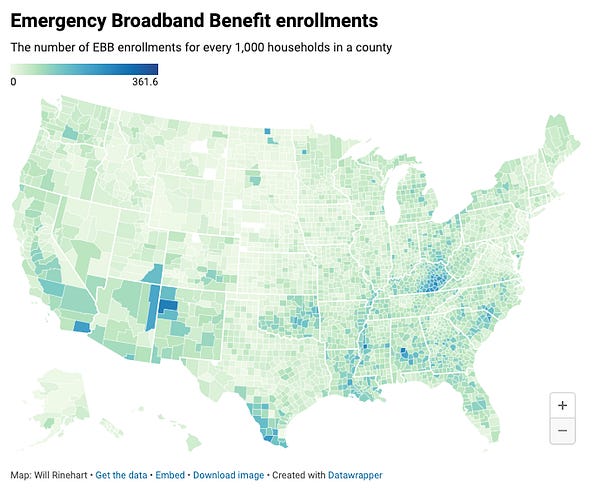A progress report on the Emergency Broadband Benefit program
As part of a larger analysis of this program, I just released new county-level data alongside two maps that break down what's happening.
Late last year, Congress set aside $3.14 billion to help low-income households pay for broadband service and connected Internet devices. Since Congress is likely to extend the Emergency Broadband Benefit (EBB) program through the infrastructure bill, I thought it would be interesting to explore what we know so far.
The Universal Service Administration Company, which is overseeing the program, continually releases Zip code level data of enrollment, but this format makes it difficult to analyze. To help in this process, I recently released a county-level dataset of the EBB data.
From here, I created two county-level maps. The second of these maps is the most detailed and includes the percent of households with Internet, total Emergency Broadband Benefit (EBB) enrollments, total EBB enrollments per 1,000 households, and the percent of households below the poverty line for every county where there is data.
The Twitter thread below offers a quick explanation of the post.



The dataset and the maps are part of a larger analysis of the program that CGO published. In the Appendix, I ran some simple quantile regressions to chart the relationships between enrollments and two other variables, poverty and not having Internet at home.
While there are a lot of caveats, these tests suggest enrollments are going towards low-income communities. In other words, households in poverty are signing up. It’s worth noting that some early analysis from Scott Wallsten found the exact opposite trend. However, he used a different method than I did for calculating poverty, which I intend to conduct in a planned update.
The broadband industry is undergoing change. The pandemic brought a strong wave of signups, a trend that is now on the wane, but it also exposed the gaps in coverage. The EBB, since it funds those in need, doesn’t do much to get Internet to those who have the means but still cannot buy a connection. The infrastructure bill is hoping to solve this broadband gap once and for all through an infusion of $42 billion to the states.
Getting broadband into every household is a laudable goal, but leaders shouldn’t be surprised if the region changes. Consider for a moment what it means to have a successful new broadband project. If a government grant is able to appreciably change how the Internet is consumed, at a minimum, local retail will be substituted for e-commerce, people will go online to consume news instead of a local newspaper, and companies will shift who and how they employ workers. I had a short explainer about this last year, but there has been a lot of new work since then filling in some gaps.
A new paper from Bergeaud, Mazet, Malgoures, and Signorelli again confirms that broadband polarizes skills. They found that that “broadband technology increases firm productivity and the relative demand for high-skill workers” leading “firms to outsource some non-core occupations to service contractors, both in the low and high-skill segments.” After the arrival of broadband internet, establishments become increasingly homogeneous in their occupational composition, and there is suggestive evidence that high-skill workers experience salary gains from being outsourced, while low-skill workers lose out.
Luyi Han at Penn State found that both adoption and access to broadband positively impacted self-employment and work-from-home for married women, though adoption had stronger effects. Research from Cambini, Sabatino, and Zaccagni discovered that the performance of Italian students isn’t largely impacted by Internet access when they are younger. As they enter 8th grade, the trend shifts, and more broadband availability means worse school performance, but only for low-income households. Broadband has a polarizing effect.
All too often when I bring up these impacts people think I am against the funding of broadband. That’s not what I am saying. There are clear benefits to funding broadband. But, I am also not trying to deny that there are costs. We need a full accounting of both to truly understand this program’s impact.
Let me know what you think because more research is on the way.

